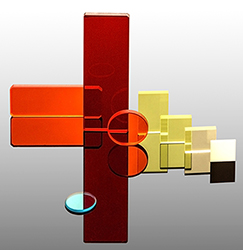p: (262) 548-1155
e: sales@advancedoptics.com
REQUEST A QUOTE
Woman Owned Small Business
Colored Glass Absorptive Filters
Colored glass absorptive filters work by absorbing specific wavelengths of light. The fraction of light absorbed is a function of the thickness of the material and the amount of dye present. Known for isolating a broad range of wavelengths they also work well in applications requiring the blocking of short wavelengths of light and transmission of longer wavelengths of light.
How to Order Colored Glass Absorptive Optical Filters
Because Colored Glass Absorptive optical filters are a very specialized service, a shopping cart purchase is not available. To request a quote or order optical filters, please fill out our Request a Quote form or call us directly at (262) 548-1155.

Advantages and disadvantages of colored glass absorptive filters include:
Advantages |
Disadvantages |
| Low cost. | If incident light is too intense the filters will heat up and deform. |
| Not sensitive to angle of incidence of incoming light. | Not suitable for high power applications. |
| Effectiveness over a wide range of wavelengths based on choice of filter. | Effectiveness dependent on thickness and therefore may need additional polishing. |
| Easy to clean and not affected by light scratches as dye is impregnated throughout the filter, chemically resistant. | Work over a specific wide wavelength range and do not offer as sharp cut-on and cut-off as dichroic filters. |
| No polarization effects. |
The Advantages of Polishing Colored Glass Absorptive Filters
The advantage of polishing color glass filters is they may not be commercially available in the proper thickness to provide the correct amount of absorption of light or in custom configurations which is where Advanced Optics can help. We custom fabricate all types of absorptive color glass filters manufactured by Hoya and Schott to your exact specifications.
For further technical information and tutorials on absorptive filters, please visit the following page published by the Florida State Research Foundation.
Specifying the Correct Optical Filter
Optical filters are classified by their construction, which determines the way they filter light. There are many types of absorptive and reflective filters and careful selection should be based on the specific application in which they will be used. One should consider the following when selecting an optical filter for a specific application: wavelength range of interest as well as cut-on and cut-off properties, AOI of incoming light, energy of incoming light and operating environment.
Whether your application requires an absorptive filter, dichroic filter or neutral density filter, carefully considering your requirements is critical. Specific consideration should be given to the physical size, shape and tolerances of the substrate as tighter tolerances may require additional manufacturing which can add cost. The same applies to the surface quality of the filter which is expressed by a scratch and dig number. The lower the scratch and dig number, the more potential there is for a reduction in yield which drives up the cost of the filter.
Selecting the proper optical filter for your application is essential to saving manufacturing time, which translates to reduced costs. Advanced Optics can help you define your requirements.
